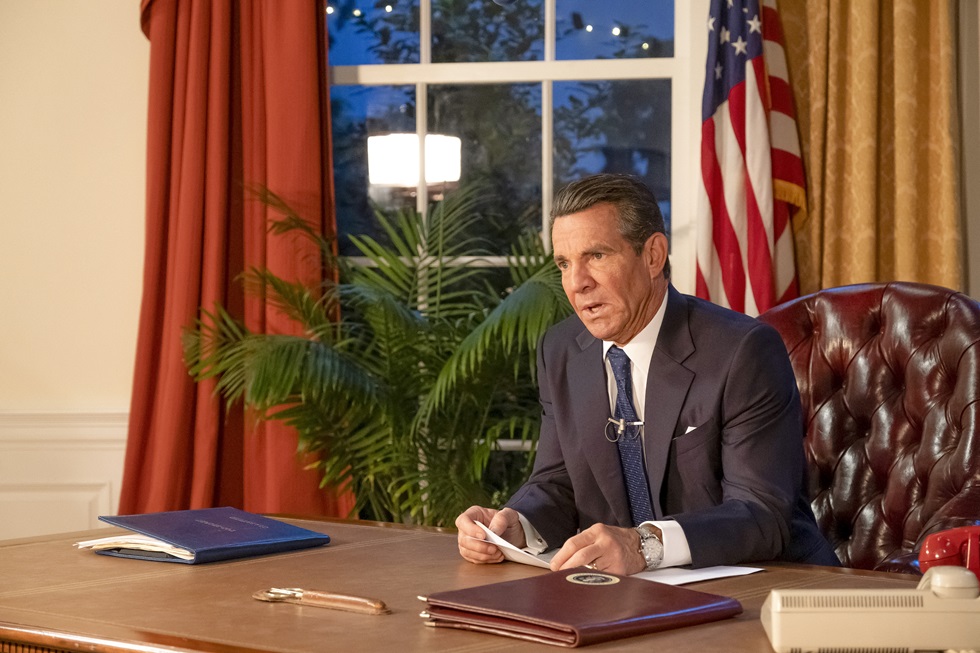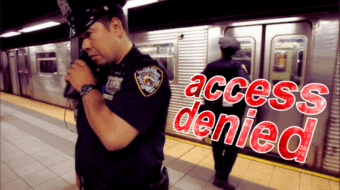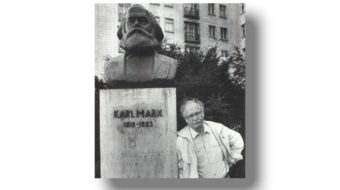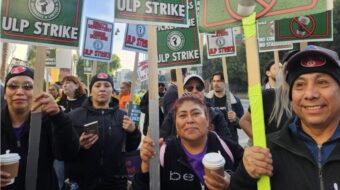
As the 2024 presidential election draws near, there has been a growing realization that ex-President Donald Trump’s second term would be detrimental to working people and the country as a whole. Among those pointing out this danger are increasing numbers of prominent Republicans.
Yet, as they condemn Trump, they have begun to wax poetic of the Republican party of yesteryear with rose-colored recollection, lovingly referencing the “party of Reagan” in all its supposed conservative glory. The new biopic, Reagan, leans into this nostalgia with ahistorical bravado and selective storytelling.
Directed by Sean McNamara and written by Howard Klausner, the biographical drama is based on Paul Kengor’s two books on the 40th president, Ronald Reagan: A Spiritual Life and The Crusader: Ronald Reagan and the Fall of Communism. The movie tells Reagan’s story through the eyes of veteran KGB agent Viktor Petrovich—who did not exist but serves as a composite of several spies who supposedly watched the president from his days as a Hollywood actor to his two terms in the White House from 1981 to 1989.
With this viewpoint, much of the story focuses on Reagan’s anti-communist sentiments and his dealings with the Soviet Union during the Cold War, giving him credit for the fall of the Berlin Wall.
The word “crusader” is often mentioned, as Reagan is portrayed as a cowboy-like heroic figure who doesn’t abide by politics on Capitol Hill and leads with his high moral ground of putting America first and the Christian teachings his mother instilled in him. This focus means that many of the details concerning his policies and controversies are glossed over for an idealized version of a man, denying audiences a more balanced and nuanced view of history.
In a technical sense, the film feels like a mainstream 1950s movie. The lighting is overly bright with a glamorized flare.
The scenes are short, with large movements, and the dialogue never goes on for too long before some instrumental background music begins to hum underneath, clearly directing the audience to feel inspired in every moment of the movie—even the most mundane. This is not an exaggeration; in nearly every scene, instrumental music begins to play that sounds like the beginning or end of a rousing Wild West movie. They lay it on thick for the two hours and twenty-one minute runtime.
Reagan was no hero
To be clear, Reagan was no hero for working-class people. During his time as the Screen Actors Guild (SAG) president from the mid-1940s through the 1950s, he did achieve some gains for his colleagues, but he also helped in blacklisting many of those in Hollywood whom he disagreed with politically.

He was an informant for the government and provided names to the Federal Bureau of Investigation (FBI) of actors whom he believed to be communist sympathizers. During a House Un-American Activities Committee hearing, Reagan testified that some guild members were associated with the Communist Party. This blacklisting would result in many progressive Hollywood figures being denied work or run out of Hollywood completely.
The film portrays this as Reagan beginning his “heroism” early on. There’s even a brief scene (before the “epic” music starts) of Reagan at a table with a number of his Hollywood colleagues in which one person, Dalton Trumbo, begins explaining to Reagan that there is a system in place that only favors the rich and is unequal for working people. Reagan seems to want to sit and argue but is pulled away by his then-wife, Jane Wyman.
This scene is played more like a throwaway in which Reagan is beginning to notice that there are some “Russian sympathizers” infiltrating Hollywood, but of course, this is a skewed view. For one, Dalton Trumbo was an American screenwriter who scripted many award-winning films. He was also one of the famous Hollywood Ten—10 motion-picture producers, directors, and screenwriters who appeared before the House Un-American Activities Committee in 1947 and refused to answer questions regarding their possible communist affiliations.
They were sent to prison for contempt of Congress and were blacklisted by the Hollywood studios. This is the history Reagan played a part in, yet it was treated like a precursor footnote to his “greater” goal of taking down the Soviet Union.
This moment in the film is exemplary of the main problem with Reagan. Every moment is reshaped to make the former president look good despite the facts of history telling us otherwise.
There’s another moment in the movie when the president is told about the Professional Air Traffic Controllers Organization (PATCO) strike. The workers were striking due to unsafe working conditions and staff shortages.
The scene has Reagan asking his assistant if the strike is legal. The attendant responds that it is not, as the workers signed a contract saying they would not strike. Reagan then says, “I was taught that if you signed a contract, you stuck by your word,” essentially condemning the strike. This scene is shaped as Reagan simply following his morals, but in reality, it was part of his anti-labor presidency.
Despite PATCO being one of the few unions to endorse his presidency, Reagan showed no mercy when, on Aug. 3, 1981, he ordered the 12,176 striking air traffic controllers back to their jobs. He gave them only 48 hours to cancel the strike and banned them from federal service for life. This ban was not lifted until 1993 by President Bill Clinton. This strike breaking was a significant blow to the union movement.
While that is perhaps the most well-known example of the former president dismissing workers’ needs, under Reagan’s presidency, the National Labor Relations Board (NLRB) that he shaped did away with several precedents that protected workers. During Reagan’s presidency, the share of employees in labor unions dropped from approximately one-fourth of the total workforce to one-sixth.
Glamorizes his time as governor
The film even glamorizes his time as governor of California from 1967 to 1975 and his clash with student protestors. Reagan’s aggression against student demonstrations came to a head when, during the 1969 People’s Park protest, the then-governor called the California Highway Patrol to the University of California, Berkeley, to subdue the protests.
A violent clash occurred that resulted in one death—by police gunfire—and several injuries. Reagan would eventually call in the National Guard. He is quoted as saying during this time, “If it takes a bloodbath, let’s get it over with. No more appeasement” about campus protests.
None of this is in the film. Instead, we get a scene of Reagan going to the University of California, Berkeley, yelling at the staff, essentially saying that they allow the students to walk all over them. He then walks through a crowd of students doing a silent sit-in protest and gives them a good-natured “shh” that makes them all laugh. One of these students, Dana Rohrabacher, eventually contacted him and would later become one of his speech writers.
Wholesome stuff.
The Iran–Contra scandal, which was a major political controversy involving the Reagan administration, is chalked up to the president having good intentions to secure hostages. This, of course, is not the whole story.
During the early 1980s, Iran was embroiled in the Iran-Iraq War and was deemed by the U.S. as a state sponsor of terrorism. The United States had an arms embargo against Iran, making any arms sales illegal.
To secure the release of American hostages held by Hezbollah in Lebanon—a group with ties to Iran—members of the Reagan administration authorized the sale of arms to Iran, thus violating the embargo. Further, the proceeds from the arms sales to Iran were then secretly funneled to the Contras in Nicaragua.
The Contras were a group that opposed the socialist-leaning Sandinista government in Nicaragua. This use of funds violated the Boland Amendment, which prohibited the U.S. from using government funds to assist the Contras.
It’s never addressed this way in the movie. Instead, there’s a brief discussion of Reagan saying he likes the Contras as they remind him of himself fighting against communist influence. He then asks if there’s a way to support their efforts but is advised that it isn’t legal to do so.
The film then alludes to the idea that a mysterious someone—it is never clarified as to who—did so anyway. When the controversy erupts, Nancy Reagan gives Ronald a rousing speech about fighting for his presidency against murmurs of impeachment.
He then gives a televised speech in which our fictional narrator, Viktor, tells us that the American public holds a grudge but will quickly forgive if you look them in the eyes and tell them the truth—as Reagan did with his televised apology.
The list goes on regarding instances where half-truths regarding Reagan’s biography are displayed. One aspect that seems to be completely glossed over is his detrimental domestic policies.
Only a tiny bit of criticism
The only criticism of his work is a quick one-minute montage of MTV-style protests against him in the 1980s. Protest signs flash rapidly across the screen from footage of demonstrations against Reagan throughout the 1980s. In this montage, we see critiques of the Reagan administration on the AIDS epidemic, the economy, and various other issues.
None of this is addressed directly in Reagan. It’s simply shown as a point in his legacy where he needed to prove he still had what it took to be president.
During the 1980s AIDS epidemic, Reagan’s refusal to acknowledge the devastating disease until the end of the decade—most likely due to it being closely related to gay men—resulted in the deaths of thousands. By the time he publicly addressed the epidemic on May 31, 1987, at an AIDS conference in Washington, DC., 36,058 Americans had been diagnosed with the disease, and 20,849 had died.
He helped to popularize the term “welfare queen,” meaning a person who abuses government assistance programs through fraudulent means. It is a term often wrongly associated with Black women, even though people of all races and genders have been welfare recipients.
He slashed programs such as food stamps and subsidized housing. Under his presidency, the poverty rate climbed from twelve percent to fifteen percent. His so-called “War on Drugs” was a disaster, unjustly targeting urban areas and communities of color.
While many people are rightfully calling attention to Project 2025 and Trump’s involvement, several of the proposals in that 1,000-page document sound similar to Reagan’s actions during his presidency.
For example, Project 2025 calls for eliminating the Department of Education. During his two terms in office, Reagan slashed federal school aid by over one billion dollars, called the Department of Education a “bureaucratic boondoggle,” and cut its budget by nineteen percent. In his 1982 State of the Union speech, Reagan called for the end of the Department of Education.
Project 2025 details a plan for gutting the Environmental Protection Agency (EPA) and strengthening the fossil fuel industry. This is especially concerning at a time when global warming and climate change threaten humanity and everything on the planet.
And while there is a focus on Trump’s weird fascination with his false idea that renewable energy—such as windmills—can cause cancer, it would be wrong not to point out how Reagan once noted that “trees cause more pollution than automobiles do.” The Reagan-appointed EPA Administrator Anne Gorsuch attempted to gut the 1972 Clean Water Act and cut the EPA’s funding by twenty-five percent.
And just as Trump and many of his allies continue their red-baiting tactics of calling anyone with progressive leanings an enemy of the country, Reagan also relished in McCarthyism-like tactics of blacklisting. Ultimately, it would seem that the MAGA Republicans aren’t that much different from the Reagan Republicans except for their lack of subtlety with their right-wing conservative values.
Reagan wants the audience to remember a horse-riding crusader who never actually was, ultimately doing a disservice to anyone looking for a more thorough biopic. The acting is decent enough with the script the performers are given, but the movie overstays its welcome with a 2:21 runtime of various scenes that all feel shallow. This critic would imagine that if you are already a fan of Reagan, then you will enjoy this slanted trip down memory lane. If you are looking for a more thought-provoking cinematic dive into a critical part of history, you’ll need to look elsewhere.
Reagan is currently playing in theaters. The trailer can be viewed here.
We hope you appreciated this article. At People’s World, we believe news and information should be free and accessible to all, but we need your help. Our journalism is free of corporate influence and paywalls because we are totally reader-supported. Only you, our readers and supporters, make this possible. If you enjoy reading People’s World and the stories we bring you, please support our work by donating or becoming a monthly sustainer today. Thank you!









